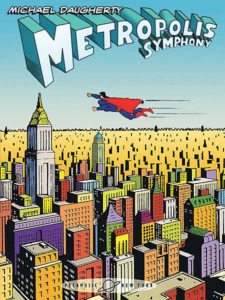Metropolis Symphony
for orchestra (1988-1993)
Instrumentation: 3 flutes, 2 oboes, 2 clarinets, 2 bassoons, 4 horns, 3 trumpets, 3 trombones, tuba; timpani, 4 percussion, synthesizer, keyboard, strings
World Premiere: January 1994 / Meyerhoff Concert Hall, Baltimore, Maryland / Baltimore Symphony Orchestra / David Zinman
Publisher:
Peermusic Classical, BMI (Americas and Asia)
Faber Music (Europe, Australia and New Zealand)
Duration: 41 minutes

Program Note:
I began composing my Metropolis Symphony in 1988, inspired by the celebration in Cleveland of the fiftieth anniversary of Superman’s first appearance in the comics. When I completed the score in 1993, I dedicated it to the conductor David Zinman, who had encouraged me to compose the work, and to the Baltimore Symphony Orchestra. The Metropolis Symphony evokes an American mythology that I discovered as an avid reader of comic books in the fifties and sixties. Each movement of the symphony—which may be performed separately—is a musical response to the myth of Superman. I have used Superman as a compositional metaphor in order to create an independent musical world that appeals to the imagination. The symphony is a rigorously structured, non-programmatic work, expressing the energies, ambiguities, paradoxes, and wit of American popular culture. Like Charles Ives, whose music recalls small-town America early in our century, I draw on my eclectic musical background to reflect on late-twentieth-century urban America. Through complex orchestration, timbral exploration, and rhythmic polyphony, I combine the idioms of jazz, rock, and funk with symphonic and avant-garde composition.
I. Lex
“Lex” derives its title from one of Superman’s most vexing foes, the supervillain and business tycoon Lex Luthor. Marked “Diabolical” in the score, this movement features a virtuoso violin soloist (Lex) who plays a fiendishly difficult fast triplet motive in perpetual motion, pursued by the orchestration and a percussion section that includes four referee whistles placed quadraphonically on stage.
II. Krypton
“Krypton” refers to the exploding planet from which the infant Superman escaped. A dark, microtonal soundworld is created by glissandi in the strings, trombone, and siren. Two percussionists play antiphonal fire bells throughout the movement, as it evolves from a recurring solo motive in the cellos into ominous calls from the brass section. Gradually the movement builds toward an apocalyptic conclusion.
III. Mxyzptlk
“Mxyzptlk” is named after a mischievous imp from the fifth dimension who regularly wreaks havoc on Metropolis. This brightly orchestrated movement is the scherzo of the symphony, emphasizing the upper register of the orchestra. It features two dueling flute soloists who are positioned stereophonically on either side of the conductor. Rapidly descending and ascending flute runs are echoed throughout the orchestra, while open-stringed pizzicato patterns, moving strobe-like throughout the orchestra, are precisely choreographed to create a spatial effect.
IV. Oh, Lois!
“Oh, Lois!” invokes Lois Lane, news reporter at the Daily Planet alongside Clark Kent (alias Superman). Marked with the tempo “faster than a speeding bullet,” this five-minute concerto for the orchestra uses flexatone and whip to provide a lively polyrhythmic counterpoint that suggests a cartoon history of mishaps, screams, dialogue, crashes, and disasters, all in rapid motion.
V. Red Cape Tango
“Red Cape Tango” was composed after Superman’s fight to the death with Doomsday, and is my final musical work based on the Superman mythology. The principal melody, first heard in the bassoon, is derived from the medieval Latin death chant “Dies irae.” This dance of death is conceived as a tango, presented at times like a concertino comprising string quintet, brass trio, bassoon, chimes, and castanets. The tango rhythm, introduced by the castanets and heard later in the finger cymbals, undergoes a gradual timbral transformation, concluding dramatically with crash cymbals, brake drum, and timpani. The orchestra alternates between legato and staccato sections to suggest a musical bullfight.
–Michael Daugherty
